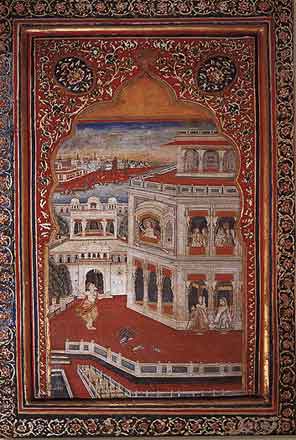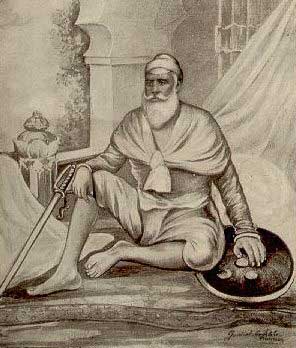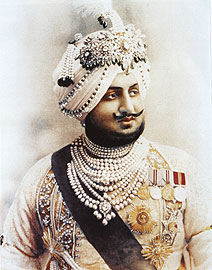Patiala is Famous for ‘peg’, ‘pagri’, ‘paranda’ 'salwaar' (tasselled tag for braiding hair and ‘Punjabi Jutti’ (footwear), joyous buoyance, royal demeanor, sensuous and graceful feminine gait and Aristocracy, Patiala presents a beautiful bouquet of life-style even to a casual visitor to the city. A brilliant spectrum of Rajput, Mughal and Punjabi cultures, a fine blend of modernity and tradition and a judicious synthesis of all that is beautiful in form and bold in spirit conjure up> a vision called 'Patiala'.
Patiala, an erstwhile princely state, capital of PEPSU and a district headquarters of Punjab are situated in the Malwa region of Punjab. Malwa has the largest number Of districts in the reorganised Punjab, and antiquity of some of the cities goes back to the ancient and early medieval period. Patiala is relatively a young city, a few years more than two centuries old.
Baba Ala Singh ji
In 1763 Baba Ala Singh laid the foundation of the Patiala fort known as Qila Mubarak,around which the present city of Patiala developed.

Qila Mubark
After the Third Battle of Panipat in 1761 in which the Marathas were defeated, the writ of the Afghans prevailed through out Punjab. It is at this stage that the rulers of Patiala began to acquire ensigns of royalty.
Ahmad Shah Abdali bestowed upon Ala Singh furm and banner, and the title of Maharaja of Patiala. After his death, his grandson Amar Singh succeeded and received the title of Raja-I-Rajaan. He was also allowed to strike coins.
After forty years of ceaseless struggle with the Mughals, Afghans and Marathas the borders of the Patiala state witnessed the blazing trails of Ranjit Singh in the north and of the British in the east. Bestowed with the grit and instinct of survival, making the right choice at the right time the Raja of Patiala entered into a treaty with the British against Ranjit Singh in 1808, thus becoming collaborators in the empire building process of the British in the sub-continent of India.
The British treated the rulers of Patiala, such as Karam Singh, Narinder Singh, Mahendra Singh, Rajinder Singh, Bhupinder Singh and Yadvindra Singh with respect and dignity.
Maharaja Bhupinder Singh
Maharaja Bhupinder Singh (Reign - 1900 to 1938) gave Patiala a prominent place on the political map of India and in the field of international sports. This included his dog kennels and he and the Maharaja of Jind were equally interested in a range of dog breeds. His son Maharaja Yadavindra Singh
Maharaja Yadavindra Singh
was the first Indian prince to sign the Instrument of Accession, thus facilitating the process of national integration after independence in 1947. In recognition of his services, he was appointed the Rajpramukh of the newly established state of Patiala and East Punjab States Union (PEPSU), from its founding in 1948 until its merger with Punjab in 1956.The downtown area of Patiala is Adalat Bazaar, which means 'the court corridor', because this was used as the administrative building by one of the caretakers, before Maharaja Bhupinder Singh had reached the age of majority. The Royal Family are Jatts of the Sidhu family, of Rajmata Mohinder Kaur of Patiala is the oldest member.



